1st October 2025
A good turnout of 16 gamers this session playing five different games featuring zoo building, cave farming, railways and Mars.
This time it was Kathy getting a game setup promptly as Ark Nova had been pitched on Discord a few hours before the session, this is a long game so an early start is recommended. This is its sixth club outing, first played in session 28.
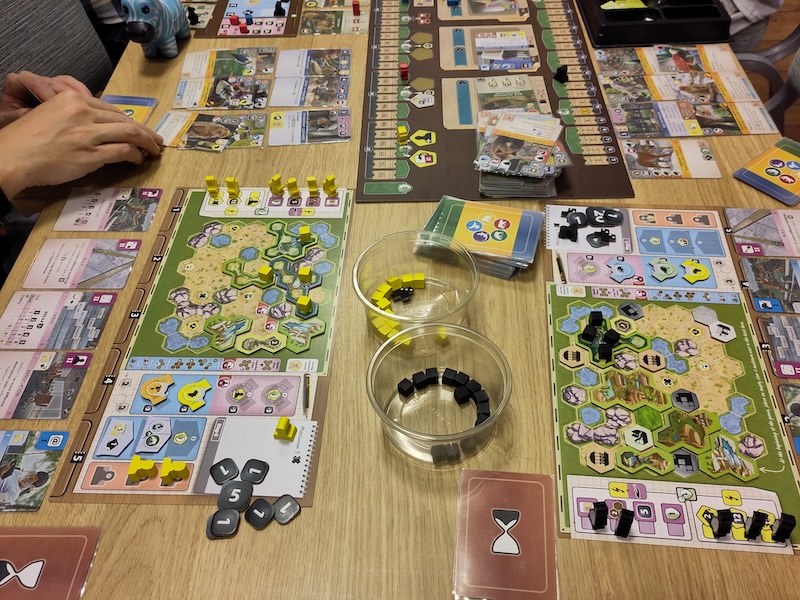
Dave and James used the beginner zoo map with a bonus starting enclosure and kiosk while Kathy and Dan used the next basic zoo with no starting features. After a few rounds everyone had the hang of the five action card sliding mechanic and the zebra player marker (house addition as sometimes turns are so quick people don’t realise it is now their go) was quickly making rounds of the table. Kathy tried getting in an early Conservation project in the second round to free up a second worker. But this backfired as in a four player game the rounds were being ended quickly to generate the much needed cash to build enclosures and acquire animals and there was no time to utilise this worker until later in the game. Then she failed to pick up animal cards to match the other conservation objectives to score more on this track later in the game.
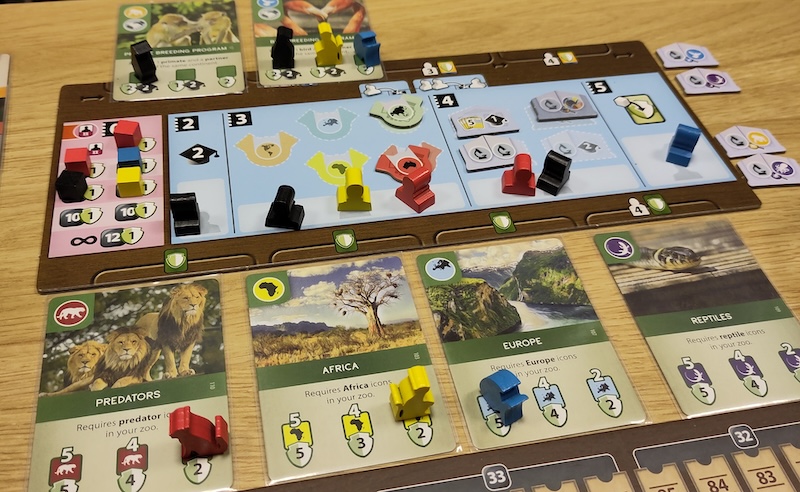
There is a large deck of possible animal cards, adding lots of variety, but also frustration or the opportunity to adapt strategy to match your draws. Meanwhile James was steadily filling his zoo and moving up the appeal track and generating good income, Dave was more successfully working on conservation projects in a European animal focused zoo and Dan was balancing both score tracks nicely. James was also powering up the final “hat” track, actually zoo reputation, and obtaining bonuses from those higher levels and as it turned out meeting his secret objective gaining him an extra 4 point conservation score at end game. Which he didn’t really need as he ended the game with a final enclosure filling move which caused his appeal and conservation score markers to cross.
Everyone else had one final turn to try and maximise their scores and then add on any end game scores which meant that Dan and Dave (just by 1 point) also achieved crossover and positive points but couldn’t beat James. Whilst Kathy’s zoo of lovely birds and monkeys from Africa and South America was lagging behind with a terrible minus 40 final score. Everyone was keen to give this another go at a future session now three more players have a better feel for all the ways to score points, but win or lose the theme and the pleasure of filling your zoo map always makes this game fun.
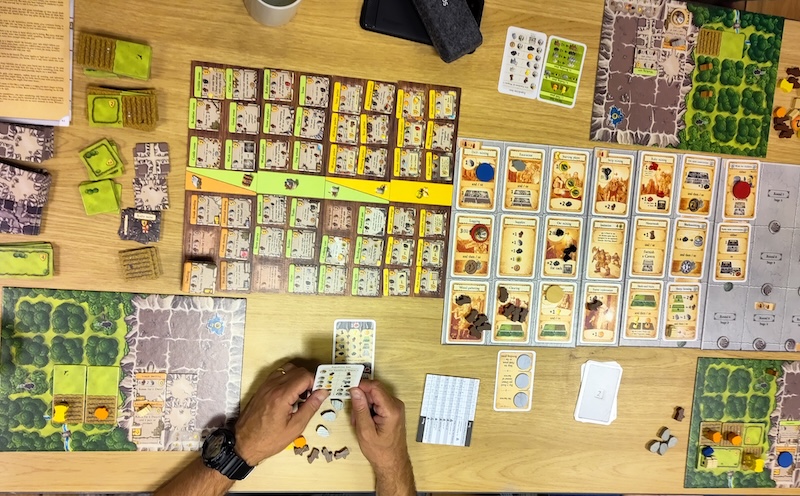
Steph also started setting up early, this time Caverna: The Cave Farmers which surprisingly for this classic game was new to the club tables.
In the worker-placement game Caverna, you lead a dwarf family living in a mountain cave. You start with a pair of dwarves and every turn you send one out to work, cutting down the nearby forest to grow crops and keep animals, excavating the mountain to create new caverns and mines or heading out on expeditions in search of loot. Most rounds end with a harvest and your hard-working dwarves must be fed, so best hope you’ve grown enough pumpkins or you’ll be eating the family pig.
This 3-player game saw experienced player Steph teaching Iain and Reynaldo the finer points of cave farming. Both new players quickly set about forging weapons and sending their dwarves on adventures, bringing back building materials, animals, in Iain’s case, even bigger weapons for all the family. Steph focussed on farming and fence building to accommodate her growing flock of sheep, while also developing a network of mines. Iain and Reynaldo expanded their dwarf families by ‘wishing for children’, and although their growing broods of offspring meant extra work got done each day, much of this was focussed on providing for all the extra mouths to feed. Ultimately, Iain and Reynaldo got in each other’s way competing for the same action spots, leaving Steph free to develop her farm without obstruction and win the game (undoubtedly helped by having played before). Second place was hotly contested but the points brought in by Iain’s weapon stores just won out over Reynaldo’s impressive farm.
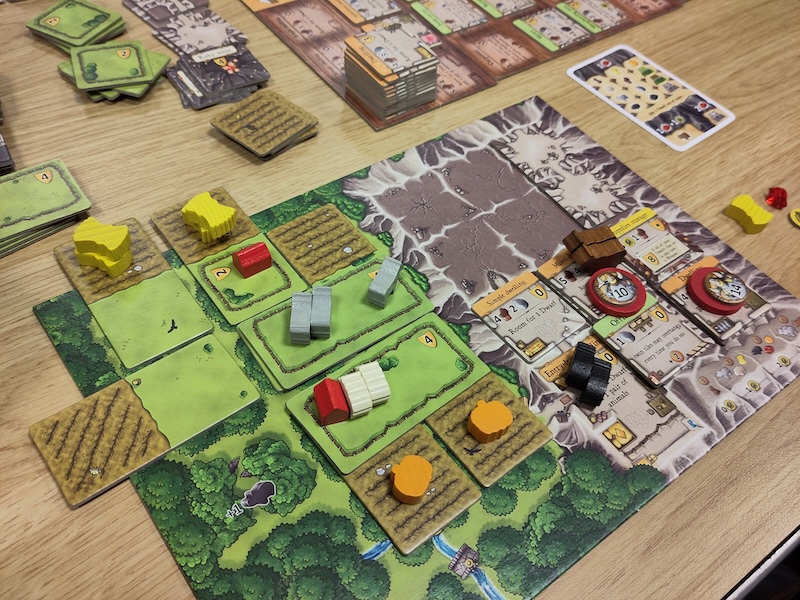
The third table chose Terraforming Mars on its ninth club play, first tried back in session 5. Five eager CEOs and prospective billionaires sat down to reap the spoils from The Red Planet. Richie headed up Treactor an Earth focussed corporation, James (the younger) took on the Mining Guild, Graham led Ecoline focussing on greening the planet, Jeremy took up position in Inventrix the IP company and Neil became CEO of Helion the heat production company.
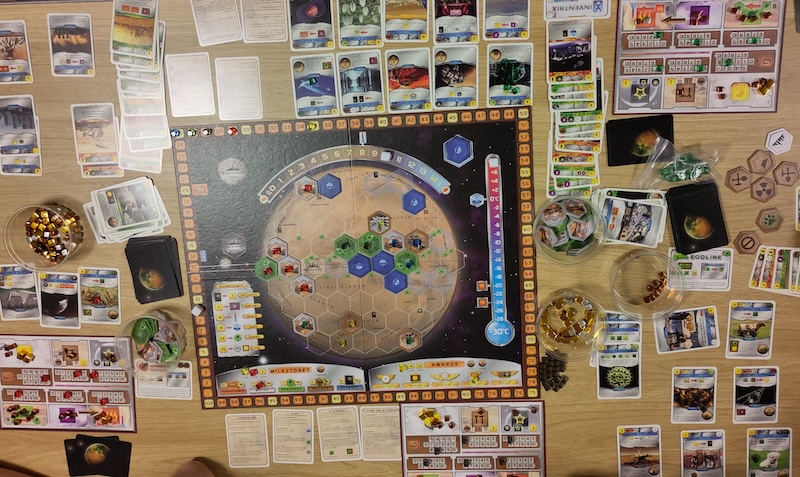
The goal of Terraforming Mars is to increase the temperature, add oxygen and create a number of oceans on the planet to make it more inhabitable. Doing these gives you Terraforming Points which is the basis of your income for your company and indicates who walks away a billionaire and who is left behind.
Though there are some standard actions you can take, to gain resources or terraform mars, they are quite costly, so mostly you end up playing project cards that give you more benefits, though do cost a small upfront amount to keep in your hand. These cards will generally increase your resource tracks such as energy, heat, plants or materials, or directly or indirectly help to terraform mars or improve the terraforming point track.
The game started off quite slowly with all the corporations having a limited number of cards or actions due to limited funds. Ecoline built an expensive Earth catapult to reduce the cost of all future projects, the Mining guild concentrated on mining, Inventrix started breeding tardigrades, Treactor focussed on some cheap Earth projects and Helion dabbled in a few bio-projects.
Two thirds through the game, Mars did not have much visible terraforming - there were a few cities, a few oceans and a few forests, but even so, the temperature had sky rocketed. Treactor, with help from Inventrix and the Mining Guild had concentrated on temperature projects and heat production, whilst Ecoline - the greening company - had diversified into producing viruses and raiders that impacted other corporations.
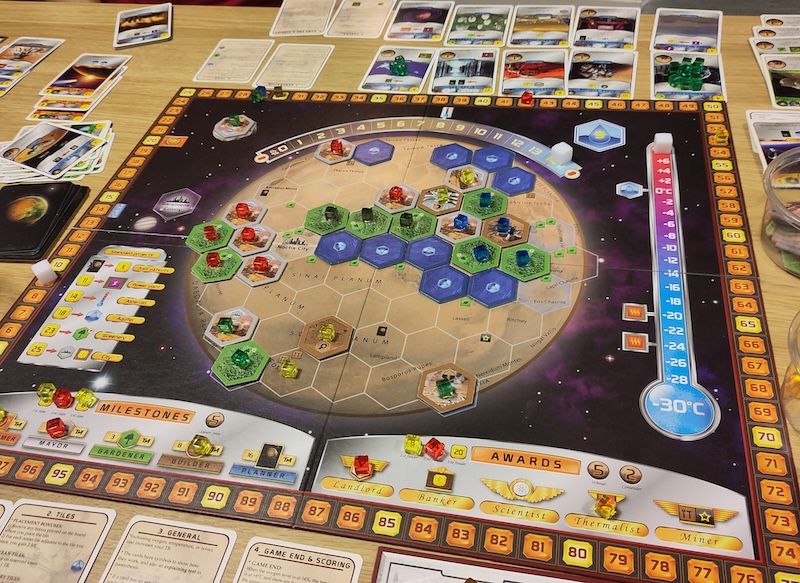
By the last turn it was clear who the contenders for the final spot were - Treactor had projects that increased their Terraforming score and so was swimming in money, the Mining Guild had also managed to corner the market and improve mars to bring in the big bucks. So both corporations had enough cash to buy the end game bonuses and awards. The last three corporations were contending for third place, Ecoline’s diversification helped with some final greening and oceans. Inventrix had built an AI to help bring in new project ideas, and was helping to bring fish to the planet. Helion’s projects were slowly coming together in plant production, but unfortunately too late to make a big impact on Mars or the final score. Treactor was declared the winner, with the Mining Guild not far behind. Third was a close thing, but Ecoline pipped Inventrix.
The final table played club favourite Ecosystem while waiting for their final player to arrive. This was its 30th play at club, our most enduring short game due to its easy teach and quick setup and playtime.
Jyo, Steve and Darren gathered to create their own dream biospheres encompassing all the flora and fauna you could ever dream of, in a 5x4 grid of cards. Steve started making a lot of noise about his wolf pack early on and tried to engage Darren in stream wars, whilst Jyo quietly got on with planting some lovely meadows. Trout, dragonflies and even thirsty deer were soon to be seen in abundance in Darren’s beautiful stream-scape which Steve’s puddle could not compete with. He managed to counter by switching to meadows, but could only match Jyo, who then matched his wolves. In the end Jyo’s meadows attracted a plethora of bees, foxes and even bears to just beat out the other two who drew for second place. A rematch was obviously in order, with Steve again trying to kick-start Stream Wars: The Trout Strikes Back, and Jyo this time creating a field of red as she collected a mass of foxes. Darren created a charming little stream to run through the shrubbery, again eclipsing Steve who had managed to upgrade from puddle to small pond, although the trout seemed to be equally happy in both this time. Steve’s park ranger had gone walk-about so the bears seized the opportunity to move in, but foxes and deer brought the victory back to Jyo – although a distinct lack of diversity in each biome meant a low-scoring game.
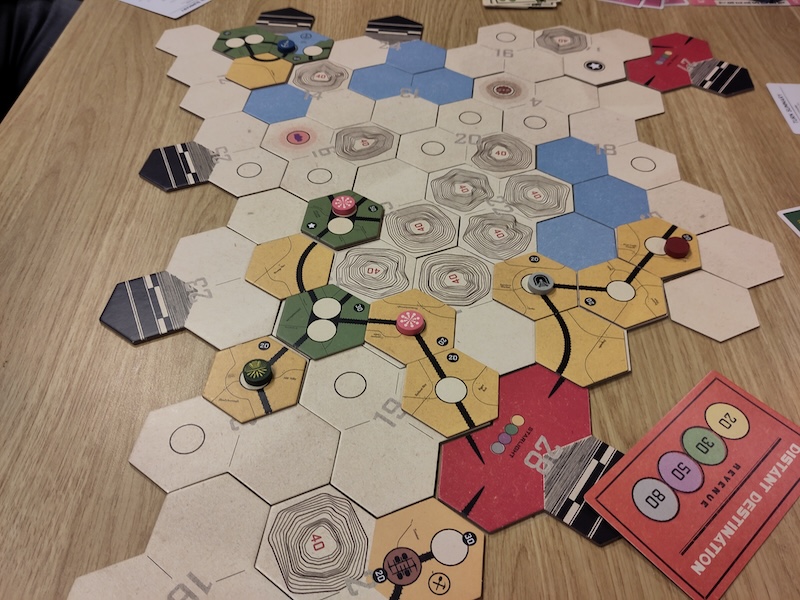
Then they got stuck into another new train game from Simon, Railways of the Lost Atlas. This game had been one of several suggestions on the Discord channel, an 18xx-style game, but designed to played in an evening so players don’t need to clear a huge space in their schedule. Aided and abetted by Jyo, this was clearly an attempt by Simon and Steve to initiate/indoctrinate Darren into the ways of 18xx under a simpler guise, although Simon was the only one to have played this particular game previously. Initial steps were to build the map at random using triple-hexes, the simple placement rules of which seemed to fry something in Darren’s sleep-deprived brain, not an auspicious start. Once the map was built and some edge adjustments made to ensure the tiles could be used the anticipated auctions began. A dozen minor companies are available at the start, but laid out in separate piles, with each auction being for choice of the top-most cards rather than specific companies, so some planning is required to figure out how you want to bid, with some companies have abilities to guide your choice. Later in the game 2 minors can be merged to form a new major company incorporating these abilities and meaning each game should see differing companies. The winning bidder chooses their company, puts the bid money into the company and gains the President’s share, with minimum bids being set by the game phase and winning bids setting share prices.
Darren opted for the Tunnel Corp to gain cash as he bored through the mountains in the Eastern section, with Steve taking the Northern Port, hidden in a Western corner away from competing corporations, Jyo hoping the extra hub afforded by the Expansive Co. would bring her fortune, and Simon holding out for Agriculture Ltd which could lay additional track after upgrading one section. This same phase also sees players sell or buy shares, dictating the share prices, and all dealings in the Stock Round are done with the player’s money.
Then followed the Operations Round – a cycle consists of 1 Stock Round, 2 Operations Rounds and a Merger Round, with the game lasting 4 cycles or 6 cycles depending on short or long game choice – where all the dealings are done with company money. For new companies the starting move is to buy a train, this is after all a train game, and without said trains the game would ground to a halt fairly quickly. Initially trains capable of travelling 2 stops are available for a mere 100 dollars, with the top available train being taken off the market at the end of the round, and prices rising as more powerful locomotives are revealed. And they have all been designed with built-in obsolescence, with the arrival of 4 stop trains causing all 2 stop trains to rust away … bye-bye Thomas.
Initial trains having been paid for, companies then decide if they want to issue or redeem any shares after seeing the state of their finances after buying a nice shiny new locomotive, and then track was laid down, hopefully leading to those shiny new purchases to actually do their thing and run the tracks, bringing in some shiny new dollars into the company coffers. Destinations have value, and the stops you hit on each run determine the money made, with the track-laying allowing you to upgrade a piece depending on the game phase, and hence bump the value of your runs. The first runs, including Steve’s tiny Hornby circuit, were mainly bringing in 40-80 shiny coins, which were then either paid out to shareholders, potentially increasing share worth, or kept in the company coffers for future use.
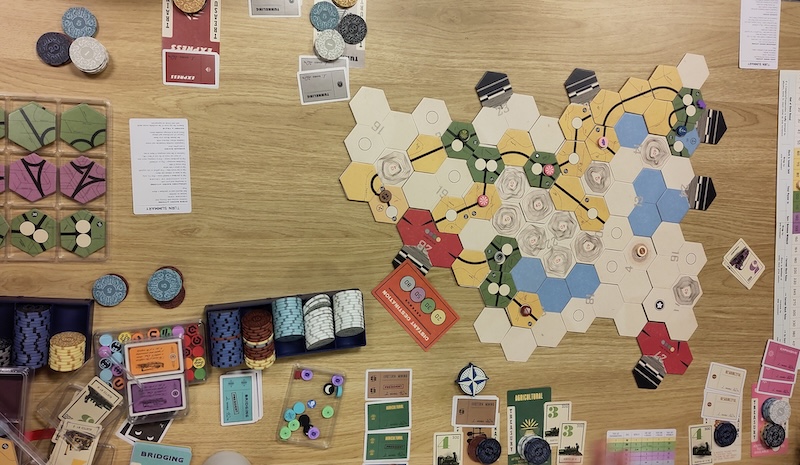
It wasn’t too long before track was wending its way across hill and dale (or over plains and mountains) as the players sought to maximise routes across the flourishing cities that were being upgraded left, right and centre. And Steve’s little Hornby circuit got an additional slightly larger circuit. New auctions saw each player controlling 2 companies and trying to strategise on how to build those networks in ways that would be meaningful if mergers took place. Then came the rise of the 4 trains, and with that the Fat Controller went full Thanos-mode, snapped his fingers, and all the 2 trains turned to rust. Luckily by now most companies were running 3 and 4 trains.
Unluckily, Darren wasn’t and watched helplessly as Gordon and Percy crumbled away. Not to worry thought the president of two companies, we’ll get some of those lovely new … ohh, how much? This was a problem, not just for reasons of running trains in a train game and earning money, but because a company has to have a train in their possession at the end of their operating round. A Faustian bargain was quickly made with Simon offering one of his many locomotives at a knock-down price (mainly because a knock-down price was all that could be afforded – novice President Darren was not exactly raking in the cash at this point). And then the shenanigans began – with one company ending the round, and then having to sell the train to the other company so that it could end their round with a train on its books, making sure to leave a pittance in each coffer so that the process of train-swapping could commence again next round. Ivor the Engine never had to deal with this.
And then the mergers started, more of an escape clause in Darren’s case, as this meant only one company, and thus only one train needed, no longer did he need to shuttle that poor overworked loco back and forth into the paint shop to get a new livery every 5 minutes. New Major Companies emerged to oversee the transport of unknown goods through unknowable locations (we had after all, Lost the Atlas) for the benefit of all. If by all we mean the shareholders, and the Presidents in particular.
Behold:
- Steve’s Northern Port Suburban System in glorious peach, blue and yellow.
- The grandiose white, pink and green of the Resourceful Expansive Firm under Jyo’s firm leadership.
- The Eastern Mining and Agricultural Union of Simon, resplendent in brown, green and orange – okay, maybe not so resplendent.
- And Darren’s burgundy, grey and purple livery of the Express Tunnelling Company Experiment. Experiment being the key word there we assume.
Track placement now became a bit more thoughtful as the players all tried to maximise potential routes with the surviving trains, all whilst hoping the big bucks weren’t spent on the available trains, especially as the 7 train was fast approaching the top of the deck, and this would cause the plentiful 4 trains to rust away if snapped up. Jyo had managed to connect tracks to Steve’s, which had now progressed beyond tiny circles, and the mergers had meant more company hubs were available, which could block other companies, and so a game of block thy neighbour commenced. Darren had managed to bore through the mountains away from competitors, whilst Simon now had a long track with multiple upgraded stations, bringing in a tasty sum.
Eventually the 7 train was bought by Darren who had somehow managed to save his pennies up, and all the 4 trains ground to a halt, rust seizing their moving parts. With a movement bonus from his merged company this allowed him to traverse 8 stations, but there were limited runs left before the game ended, and it wasn’t enough, especially after paying out for that 7 train. Somehow Steve’s Hornby tracks had managed to gain him the upper hand, although everyone had managed to get over 1000 and were all within a 150 or so of each other. And then everyone was treated to a victory … ’dance’? … by Steve in his humble celebration.
The next session is the 15th October, this coincides with the St Ives Fair so we will need to use the back door of the Corn Exchange and experience the lights and sounds of the festivities on the street outside at the start of the session. As always just turn up and see what games are available or join the Discord chat to suggest or sign up in advance.
- Total Session Attendance: 16
-
Board Games: